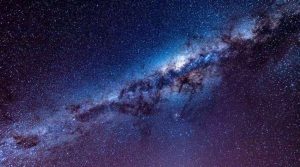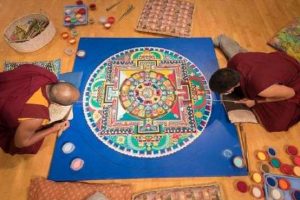
Is Amitabha truly existent?
We know about Amitabha Buddha from the three Pure Land sutras spoken by the historical Buddha, Shakyamuni. However, just as Shakyamuni tells Queen Vaidehi in the Contemplation Sutra, as we are ordinary beings without the “divine” eye, we are incapable of visualizing Amitabha—a Buddha with a reward body, or his Land of Bliss—a reward land of unconditioned nirvana.
Introducing the teaching of Amitabha’s deliverance in the sutra, Shakyamuni first has to convince us that this is possible by elucidating how the “intangible” and “invisible” Amitabha Buddha is truly existent; only then will we entrust ourselves to him, seek his deliverance, and wish to be reborn in his Pure Land.
Do not think this is an easy task! As Shakyamuni says in the Amitabha Sutra: “In this Saha world, during the evil period of the five defilements—those of time, views, passions, sentient beings, and life span—I have attained the highest, perfect Enlightenment and, for the sake of sentient beings, have delivered this teaching, which is the most difficult in the world to accept in faith.”
But is Amitabha Buddha just a legendary figure, or a deity in the ethereal realms? In the Contemplation Sutra, Shakyamuni Buddha, being aware of Queen Vaidehi’s uncertainty, promises to let her see Amitabha through his own expedient power. In response to Shakyamuni’s promise, Amitabha Buddha manifests and appears before Queeh Vaidehi in the Seventh Contemplation.
The sutra says: “Amitayus [another name of Amitabha] appeared in the air above, attended on his left and right by the two Mahasattvas, Avalokiteshvara and Mahasthamaprapta.” Amitabha’s appearance is witnessed by Queen Vaidehi, on behalf of all ordinary beings who will live after Shakyamuni’s parinirvana. Through her testimony, we know that Amitabha Buddha truly exists.
How does Amitabha Buddha connect with us?
Vaidehi nonetheless puts another practical question to Shakyamuni: “World-honored One, through your power, I have been able to see Amitayus and the two bodhisattvas; but how can the sentient beings of the future see them?”
This is a very good question. The Buddha answers: “Those who wish to see that Buddha should invoke and contemplate him, forming an image of a lotus flower on the seven-jewelled ground.” Clearly, this is an instruction given to the practitioners of meditative virtue who wish to see the Buddha through self-powered contemplative practice, so that they can realize the Samadhi of Buddha-contemplation.
However, in the Eighth Contemplation, Shakyamuni Buddha speaks of the characteristics of the “dharma realm body” (or true form body; dharmakaya in Sanskrit) of all Buddhas. Shakyamuni Buddha says: “Because Buddhas, Tathagatas, have dharma realm bodies . . . [they] enter into the invoking mind of each sentient being.”
Why is this so? Master Shandao explains this sentence in his commentary on the Contemplation Sutra as follows: “For ‘dharma realm,’ there are three meanings: 1. The mind being omnipresent means dharma realm. 2. The body being omnipresent means dharma realm. 3. Being unobstructed means dharma realm.”
Shakyamuni further says: “For this reason, when you invoke or contemplate a Buddha, the mind itself takes the form of his 32 physical characteristics and 80 secondary marks. Your mind produces the Buddha’s image, and is itself the Buddha. The ocean of perfectly and universally enlightened Buddhas thus arises in the invoking or meditating mind.”
These are the common characteristics of the dharma realm body of all Buddhas, so whenever and wherever we invoke a Buddha (especially through recitation of the Buddha’s name), that Buddha will enter our invoking mind immediately without any obstruction. This happens regardless of whether or not we experience the Buddha’s presence, or whether or not we believe in or understand the teaching.
Those who invoke or recite Amitabha’s name connect with Amitabha immediately. Nothing can prevent Amitabha Buddha from reaching us through his name. This point is crucially important for ordinary beings to understand, as it helps to build up our faith in Amitabha, who can commune with us at any time and in any place, even though we cannot see him.
Amitabha reciters are universally embraced and protected by his light
Thirdly, in what ways and by what means can the Buddhas enter our invoking mind? This varies with different Buddhas. In the case of Amitabha Buddha, he enters our invoking mind by way of his light. Shakyamuni Buddha tells us in the Ninth Contemplation: “The Buddha Amitayus possesses 84,000 physical characteristics, each having 84,000 secondary marks of excellence. Each secondary mark emits 84,000 rays of light, each light shining universally upon the lands of the ten quarters, embracing, and not forsaking, those who are mindful of the Buddha [Amitayus].”
In other words, Amitabha’s dharma realm body takes the form of light that can embrace, without forsaking, those who are mindful of him. Amitabha’s light is so splendid that it is impossible to describe in detail these rays of light—or the physical characteristics and marks of the nirmanakaya (or “transformation body”) Buddhas emanated by his light, and so forth. But the Buddha can allow us to see him clearly with our mind’s eye, as it says in the Contemplation Sutra.
Shakyamuni Buddha states: “Those who have envisioned them see all the Buddhas of the ten quarters. Because they see the Buddhas, this is called the Samadhi of Buddha-invocation.” This samadhi is the narrative highlight of the Contemplation Sutra.
Alternatively, if one attains this contemplation and perceives the bodies of all the Buddhas, it is known as the Samadhi of Buddha-contemplation—another major highlight of the Contemplation Sutra, as indicated by Master Shandao.
In either case, when the practitioner sees Amitabha Buddha, he also realizes the Buddha’s mind. What is the Buddha’s mind? As defined by Shakyamuni: “The Buddha’s mind is Great Compassion. It embraces sentient beings with unconditional benevolence.”
All those who have seen Amitabha Buddha will be born in his presence after death and realize the insight of the non-arising of all dharmas. For this reason, we should always exclusively invoke Amitabha Buddha and recite his name. Exclusive Amitabha-recitation is an indicator of our faith in Amitabha’s deliverance.
Master Shandao concludes his explication on the active principle of Amitabha’s deliverance in the Praise of the Rites of Rebirth as follows: “The honorable Amitabha set forth an extremely serious vow. He teaches and delivers sentient beings in the ten directions with his name in the form of light. It enables them to have faith, aspiration, and the practice of Amitabha-recitation. Whoever recites until the end of his life—even as few as ten times, or just one time—can be easily reborn by the power of his great vow.”













